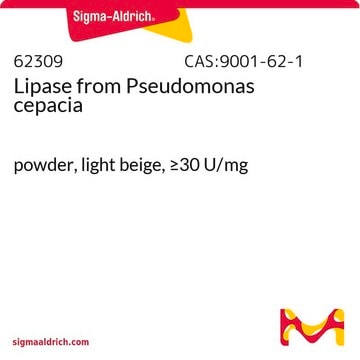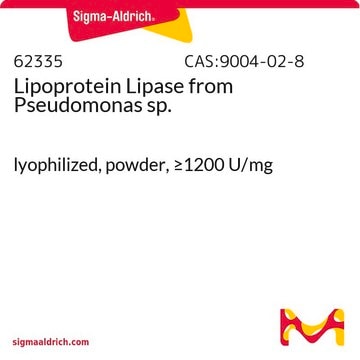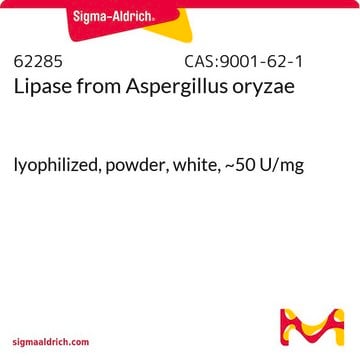L9518
Lipase from Pseudomonas sp.
Type XIII, lyophilized powder, ≥15 units/mg solid
Synonyme(s) :
Extracellular lipase, Triacylglycerol ester hydrolase, lip, Triacylglycerol acylhydrolase, Triacylglycerol lipase
About This Item
Produits recommandés
Type
Type XIII
Forme
lyophilized powder
Activité spécifique
≥15 units/mg solid
Poids mol.
~134 kDa
Composition
Protein, 40-65% biuret
Température de stockage
2-8°C
Description générale
Lipases are part of the α/β-hydrolase fold superfamily of enzymes and are expressed in various tissues. For instance, hepatic lipases are found in the liver, lipoprotein lipase is located on the vascular endothelial surface, hormone-sensitive lipases are present in adipocytes, and pancreatic lipase is situated in the small intestine.
Application
- for enzymatic determination of triglyceride in serum when coupled with L-α- glycerophosphate oxidase (G3O-301, G3O-311, G3O-321) and glycerol kinase (GYK-301, GYK-311).
- in a study to assess enzymatic synthesis of biodiesel from palm oil assisted by microwave irradiation.
- in determining the triglyceride content for identifying the role of gut bacteria in host health.
- to determine the effect of lipase on high-density lipoprotein 2 (HDL2) and plasma in vitro.
Actions biochimiques/physiologiques
Propriétés physiques
Inhibitors : Hg++, Ag+, ionic detergents
Optimum pH : 7.0 - 9.0
Optimum temperature : 45 - 50oC
pH Stability : pH 7.0 - 9.0 (25oC, 20hr)
Thermal stability : below 55oC (pH 7.0, 10min)
Définition de l'unité
Forme physique
Remarque sur l'analyse
Code de la classe de stockage
11 - Combustible Solids
Classe de danger pour l'eau (WGK)
WGK 3
Point d'éclair (°F)
Not applicable
Point d'éclair (°C)
Not applicable
Équipement de protection individuelle
Eyeshields, Gloves, type N95 (US)
Certificats d'analyse (COA)
Recherchez un Certificats d'analyse (COA) en saisissant le numéro de lot du produit. Les numéros de lot figurent sur l'étiquette du produit après les mots "Lot" ou "Batch".
Déjà en possession de ce produit ?
Retrouvez la documentation relative aux produits que vous avez récemment achetés dans la Bibliothèque de documents.
Les clients ont également consulté
Protocoles
Assay Procedure for Lipase
Enzymatic assay of lipase type XIII from Pseudomonas sp. using a coupled enzyme system of glycerol kinase and glycerophosphate oxidase (EC 3.1.1.3)
Notre équipe de scientifiques dispose d'une expérience dans tous les secteurs de la recherche, notamment en sciences de la vie, science des matériaux, synthèse chimique, chromatographie, analyse et dans de nombreux autres domaines..
Contacter notre Service technique











